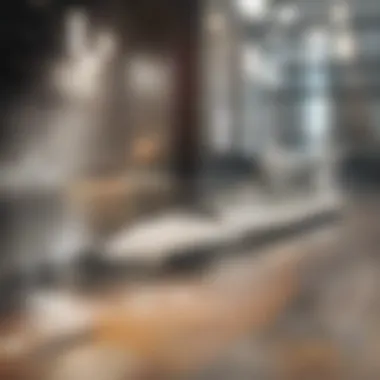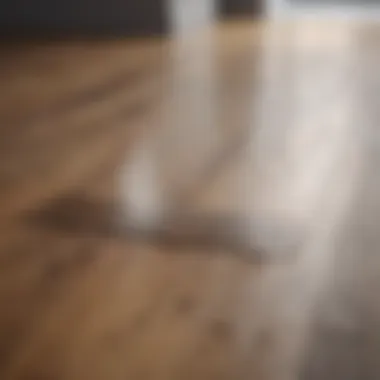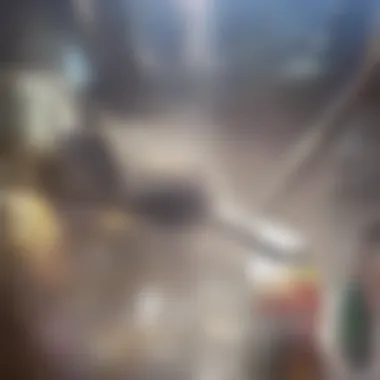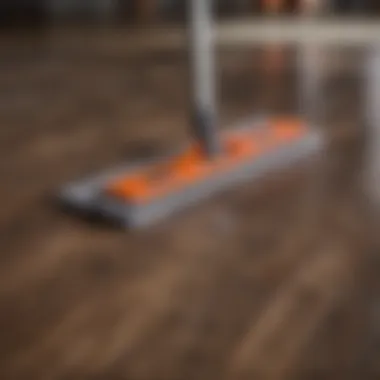The Implications of Using a Steam Mop on Laminate Floors


Intro
Maintaining the appearance and durability of laminate floors is crucial for homeowners. In recent years, steam mops have gained popularity as a cleaning tool, praised for their efficiency and hygienic results. However, the implications of using a steam mop on laminate surfaces warrant careful consideration.
This article delves into the risks associated with steam cleaning laminate floors. It will address potential damage, the unique characteristics of laminate materials, and alternative cleaning methods that may be more suitable. By understanding both the benefits and drawbacks, homeowners can make informed decisions about their cleaning practices, ensuring the longevity and aesthetic of their laminate flooring.
Understanding Laminate Flooring
Understanding laminate flooring is critical for homeowners who wish to maintain the aesthetic and functional integrity of their floors. The implications of improper maintenance or cleaning practices, such as using steam mops, can lead to significant long-term issues.
Laminate floors are a popular choice because they offer a combination of style, durability, and affordability. However, they consist of several layers that contribute to their functionality and appeal. Knowing what laminate floors are made of, their characteristics, and how to care for them is essential for making informed decisions about their maintenance.
Composition of Laminate Floors
Laminate flooring is made up of four primary layers:
- Wear Layer: This top layer is designed to resist scratches and stains, keeping the flooring looking new for longer.
- Design Layer: Beneath the wear layer is a high-resolution image of wood or other materials, giving laminate its appealing look.
- Core Layer: This middle layer is typically made from high-density fiberboard. It provides stability and strength to the floor, mimicking the feel and density of natural wood.
- Backing Layer: The bottom layer helps to provide moisture resistance and adds to the overall durability of the flooring.
Understanding the composition is essential when considering cleaning methods, as certain practices may compromise these layers.
Characteristics of Laminate Materials
Laminate materials possess unique characteristics that set them apart from traditional hardwood or tile floors. Among these characteristics are:
- Moisture Resistance: While laminate can resist spills, it is not waterproof. Excess moisture can seep into seams and cause damage.
- Affordability: Laminate offers the appearance of wood or stone at a lower price point. This makes it accessible for many homeowners.
- Customization: With a variety of designs and finishes available, laminate can suit various interior styles.
- Ease of Installation: Many laminate options feature a click-lock mechanism for straightforward installation.
These characteristics are vital when contemplating cleaning solutions, given that some methods may go against laminate’s inherent properties.
Durability and Care Factors
The durability of laminate floors depends not only on their composition but also on regular care practices. Several factors influence their lifespan:
- Foot Traffic: High-traffic areas require more frequent cleaning and attention.
- Appropriate Cleaning Products: Using the right cleaners can prevent damage and maintain appearance. Avoid harsh chemicals and steam cleaning.
- Regular Maintenance: Sweeping and occasional mopping with the right tools can keep laminate looking fresh for years.
Steam Mops: Mechanism and Use
Steam mops have gained popularity among homeowners for their ability to clean surfaces using steam instead of chemicals. Understanding how these devices function and their advantages is key to evaluating their use on laminate floors. This section delves into the mechanics of steam mops and the benefits they can offer, while also considering aspects critical to maintaining laminate flooring.
How Steam Mops Work
Steam mops operate by heating water in an internal reservoir until it turns to steam. This steam is then released through a cleaning pad that contacts the floor surface. The heat from the steam helps to break down dirt, grime, and stains, allowing for easier removal without the need for harsh chemicals.


The process is relatively straightforward:
- Heat Generation: The mop heats water to a high temperature, creating steam.
- Steam Release: The steam is emitted from the mop head, targeting dirty areas.
- Cleaning Action: As the mop glides across the surface, the steam sanitizes while the pad absorbs the loosened dirt.
Some steam mops also provide adjustable steam levels, allowing users to modulate steam output for different cleaning needs. This feature can be particularly valuable for various floors and situations.
Advantages of Steam Cleaning
Steam cleaning offers several benefits compared to traditional mopping. Here are some key advantages:
- Chemical-Free Cleaning: Since steam mops solely rely on steam for cleaning, they reduce the need for cleaning agents, which can leave residues or irritate sensitive individuals.
- Effective Bacteria Elimination: The high temperature of the steam can kill most bacteria and germs, leading to a more hygienic surface.
- Quick Drying: Steam cleaning often shortens drying time compared to traditional methods, as the moisture is generally less.
"Steam cleaning can effectively tackle stubborn dirt and maintain cleanliness with minimal effort."
- Versatility: Many steam mops come with attachments designed for different surfaces, which can increase their utility in a home.
Nonetheless, it is essential to consider these advantages in the context of laminate flooring to avoid potential pitfalls that may arise from steam use. By understanding both the mechanics and benefits of steam mops, users can make informed decisions about their cleaning practices.
Compatibility of Steam Cleaning with Laminate Floors
Understanding how steam cleaning interacts with laminate flooring is crucial for homeowners. Many people rely on steam mops for their convenience and effectiveness. However, laminate floors have unique properties that require careful consideration. This section delves into the specific elements, benefits, and considerations surrounding the compatibility of steam cleaning with laminate floors.
Risks of Using Steam Mops
Steam mops generate high-temperature steam to sanitize surfaces. Though this sounds beneficial, it poses risks to laminate flooring. One significant concern is the amount of moisture that a steam mop can leave behind. Laminate is a composite material; prolonged exposure to water can seep into the seams and lead to swelling or delamination. These outcomes can compromise both the appearance and functionality of the flooring.
Another risk is related to the temperature of the steam. If the steam is too hot, it might affect the laminate's coatings or finishes, resulting in distortion. Additionally, many laminate floors are not designed to handle the intense heat and humidity from steam cleaning. This could lead to unwanted wear and a shorter lifespan for your flooring.
Effect on Surface Integrity
The surface of laminate flooring is generally designed to resist scratching and staining. When using a steam mop, the intense heat can release adhesives used in the laminate, potentially causing surface issues.
Moreover, the pressure from the mop can create scratches or marks that are difficult, if not impossible, to repair. Although laminate flooring is often regarded as durable, steam cleaning can negatively affect its top layer. The finish may become dull or lose its luster over time with repeated steam cleaning, leading to a need for costly repairs or refinishing.
It is essential for homeowners to keep this in mind. Assessing the condition and type of your laminate floor can guide you on whether steam cleaning is a feasible option.
Potential for Warping and Damage
Warping is one of the most concerning potential damages associated with steam cleaning laminate floors. When steam penetrates the seams or edges of the flooring, the material can absorb moisture, leading to warping or buckling. This is particularly common in lower-quality laminate products, which may use adhesives that are less resistant to moisture.
Once warping occurs, it often requires replacing sections of flooring or sometimes the entire floor. The cost implications of such repairs can be significant. The risk of moisture damage makes it clear that homeowners should consider alternate cleaning methods that do not involve steam,


Best Practices for Cleaning Laminate Floors
Following best practices for cleaning laminate floors is vital. Neglecting these practices can lead to premature wear, loss of shine, or even permanent damage. Understanding how to maintain the appearance and longevity of your flooring will enhance the overall aesthetics of your home while safeguarding your investment. This section covers key cleaning methods, tools, and recommended frequency to keep your laminate floors looking fresh.
Recommended Cleaning Methods
When it comes to cleaning laminate flooring, gentleness is essential. Many homeowners mistakenly think that steam mops are safe due to their convenience. However, it is better to avoid them altogether. Instead, focus on these effective cleaning methods:
- Dry Dust Mopping: Use a microfiber cloth or a dust mop. This method captures dust and dirt without moisture, which can warp laminate over time.
- Damp Mopping: Occasionally, you may need a damp mop for deeper cleaning. When using this method, ensure the mop is well-wrung out. Avoid soaking the surface, as excessive water can damage the laminate.
- Using Mild Detergents: If stubborn stains are present, use a mild detergent mixed with water. Always test on a small, inconspicuous area first. After mopping with detergent, follow with a clean damp mop to rinse the floor from any residue.
Tools for Effective Maintenance
The choice of cleaning tools is just as critical as the cleaning methods used. Here is a list of recommended tools:
- Microfiber Mop: This is excellent for both dry and damp cleaning. It attracts dirt particles without scratching the surface.
- Broom/Soft Bristle Brush: Regular sweeping prevents dirt build-up. Opt for a soft-bristle brush to avoid scratching.
- Vacuum Cleaner: Use one that is designed for hard floors. Avoid vacuums with a rotating brush as they may cause damage.
- Mild Floor Cleaner: Choose one specifically for laminate. This ensures compatibility with the materials used in laminate flooring.
Frequency of Cleaning
The frequency of cleaning your laminate floors can greatly influence their upkeep. Here are some guidelines:
- Daily Maintenance: A quick dry dust mop or vacuuming should be done daily, especially in high-traffic areas. This helps to prevent dirt accumulation.
- Weekly Cleaning: A damp mop once a week will keep your floors in better condition. This can be altered based on the level of foot traffic.
- Deep Cleaning: Every few months, consider a thorough clean with a mild detergent. Ensure to follow with a damp mop to remove any residue.
Regular maintenance not only keeps laminate flooring looking pristine but also extends its lifespan. Appropriate cleaning practices are essential for preserving its beauty.
By adhering to these best practices, homeowners can maintain laminate floors effectively and avoid common pitfalls associated with improper cleaning. This ensures a beautiful appearance and extends the life of the flooring.
Alternative Cleaning Solutions
Considering the potential risks that steam mops pose to laminate flooring, it becomes crucial to explore alternative cleaning solutions. These methods not only protect the integrity of the floors but also ensure they remain visually appealing and functional over time. In this section, we address the practical benefits and considerations for alternative cleaning techniques.
Dry Mopping Techniques
Dry mopping is often a preferred choice for laminate floor maintenance. This technique minimizes moisture exposure, which is critical for preventing warping or delamination. When using a dry mop, it is essential to select an appropriate material—microfiber mops work well. Here are a few key points to remember:
- Frequency: Dry mopping should be done regularly to collect dust and small debris.
- Technique: Use gentle, sweeping motions rather than aggressive scrubbing. This will prevent scratches.
- Attachments: Consider using mop pads that are washable. They are effective and environmentally friendly.
Dry mopping can effectively lift the grime and dirt from the surface without risking damage from excessive moisture.
Using Mild Detergents
When it is necessary to deep clean laminate floors, using mild detergents is a sensible option. Harsh chemicals can harm the finish of the laminate, leading to dullness and loss of sheen. It is wise to choose cleaners that are specifically formulated for laminate surfaces. Here are some considerations:


- Dilution: Always dilute the detergent according to the manufacturer instructions. Les is more, making a weaker solution often suffices.
- Testing: Before applying on the entire floor, test the solution on a small, inconspicuous area. This helps ensure compatibility and prevents unintentional damage.
- Rinsing: After mopping with detergent, follow up with a rinsing pass using clean water to remove any residue; this ensures a clear finish without streaking.
Using mild detergents enhances the cleaning process while safeguarding the material’s integrity.
Natural Reinigung Methods
Natural cleaning methods are also gaining popularity as viable alternatives. Many homeowners seek environmentally friendly solutions, free from harmful chemicals. Here are some effective natural cleaning approaches:
- Vinegar and Water: A mixture of vinegar and water can effectively eliminate dirt and bacteria on laminate flooring. Mix one cup of white vinegar with a gallon of water and mop as usual.
- Baking Soda: For stubborn stains, a paste of baking soda and water can work wonders. Apply it to the stain, let it sit for a few minutes, then wipe it away.
- Essential Oils: Adding a few drops of essential oils, like tea tree or lavender, to your natural cleaner can not only enhance the scent but also provide antibacterial properties.
Adopting these methods not only provides an effective cleaning routine but also promotes a healthier living environment.
Using alternative cleaning solutions can extend the life of laminate flooring while ensuring it retains its aesthetic appeal.
Common Misconceptions about Laminate Care
The maintenance of laminate flooring often comes with misunderstandings that can affect its longevity and appearance. Homeowners may think they can apply the same cleaning methods universally across different types of floors, leading to potential mishaps. Understanding these misconceptions is essential to protect your investment and to keep your floors in optimal condition.
Steam Cleaning is Always Safe
One common belief is that steam cleaning is universally safe for all types of flooring, including laminate. This notion can result from an incorrect assumption that steam, being clean and hot, poses no risk. However, while steam mop technology has its merits, laminate floors are crafted with a combination of materials that can be adversely affected by excessive moisture and heat. The steam can seep into the seams of laminate, which may compromise the integrity of the floor, leading to warping or swelling over time. This misconception disregards the specific requirements of laminate care. Therefore, it is crucial for homeowners to be aware of the material properties and the maintenance practices suited for laminate flooring.
Harsh Chemicals Do No Harm
Another misleading idea is that harsh cleaning agents are effective and harmless on laminate surfaces. Many homeowners might resort to using strong chemicals, believing they will result in a deeper clean. In reality, such agents can lead to discoloration and deterioration of protective layers on the laminate. Products containing bleach or ammonia can strip away finishes, leaving floors vulnerable. Such damage not only affects the look but can also decrease the lifespan of the flooring. Homeowners should be encouraged to choose pH-neutral or manufacturer-recommended cleaning solutions for maintaining the integrity of their floors.
All Floor Types are the Same
The notion that all floor types require the same care is another misconception worth addressing. Each flooring type, whether it is hardwood, tile, or laminate, has distinct characteristics and care requirements. Laminate flooring, in particular, is engineered with a specific construction that responds differently to various cleaning methods. Assuming that laminate can be maintained in the same way as more resilient tile may lead to adverse reactions, such as water exposure or chemical degradation. This highlights the importance of understanding laminate as a unique flooring solution that demands particular care practices.
In summary, removing these misconceptions is crucial for the proper maintenance of laminate flooring. Homeowners should adapt their cleaning methods to the specific requirements of the materials they are working with.
Ending
The decision to use a steam mop on laminate floors warrants careful consideration, particularly given the unique attributes of laminate materials and the potential risks involved. This article emphasized several critical points, including the inherent properties of laminate flooring, the mechanisms of steam mops, and the compatibility of steam cleaning with laminate surfaces.
One crucial takeaway is the notion that while steam cleaning can be effective for various types of flooring, it may not be the best approach for laminate floors. This stems from its vulnerability to moisture and heat. Homeowners should prioritize methods that ensure longevity and maintain the aesthetic appeal of their floors rather than risking potential damage from excess moisture and temperature.
Additionally, the exploration of alternative cleaning solutions is significant. Techniques like dry mopping, using mild detergents, and natural cleaning methods provide effective maintenance without compromising the integrity of the floor. The benefits of these alternatives extend beyond protecting the laminate surface; they also contribute to a healthier indoor environment.
In essence, the conversation around steam mops and laminate flooring is not solely about cleaning efficiency; it encapsulates the broader theme of responsible and informed floor care. A thoughtful approach to maintaining laminate flooring recognizes the delicate balance between cleanliness and preservation, ensuring that these surfaces continue to enhance the home environment for years to come.
Final Recommendations
- Avoid Steam Mops: Use traditional cleaning methods to ensure the longevity of laminate flooring. Excess moisture from steam can lead to warping.
- Regular Maintenance: Implement a routine cleaning schedule. Regular dry mopping removes dirt and extends the life of the finish.
- Mild Detergents: When additional cleaning is needed, opt for a solution of mild detergent and water. This avoids harsh chemicals that could deteriorate the laminate.
- Natural Solutions: Consider using vinegar diluted in water as a natural cleaning alternative. It is safe for laminate and helps in maintaining its luster.
"Maintaining laminate floors requires a proactive approach, focusing on safe cleaning practices to ensure both appearance and durability."
Following these recommendations can provide peace of mind to homeowners concerned about the welfare of their laminate floors, while also preserving their aesthetic appeal.







